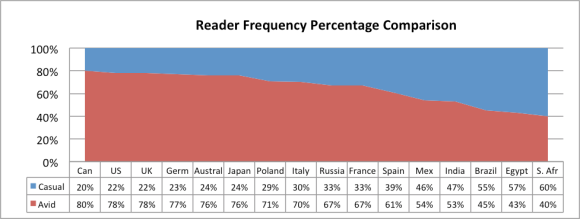Every month approximately 400 million unique visitors across the globe read Wikipedia and its sister sites. But very little is known about them. In order to understand our readers and their relationship with Wikipedia, to bring their voice into our product strategy and to enhance their reading user experience, we conducted an online survey of Wikipedia readers across 16 countries (you can find out more about the methodology of the study below). We’ll be sharing findings from the study in a series of blog posts through the end of this year. To begin, here is our first blog post that provides demographic information about our readers and their reading habits.
Contents
- Average Wikipedia reader is 36 years old
- Almost half of Wikipedia readers visit the site more than 5 times a month
- Wikipedia has slightly more male readers than female
- Methodology
Average Wikipedia reader is 36 years old
Since its founding over 10 years ago, Wikipedia has emerged as a serious knowledge website, and repository of online information. The data from the survey shows that appeal of Wikipedia is spread across ages. Wikipedia readers are at different life-stages: students, young professionals, older adults and the elderly with an age range of 14-92 years (note: we didn’t survey anyone younger than 14 years for the study). The research showed that, contrary to the popular perception that most Wikipedia readers are school students who rely on Wikipedia for schoolwork, the average age of a Wikipedia reader is 36.59 years, and the median is 35 years. As expected, countries with a large youth population (India, Mexico and Egypt) have slightly younger readers, but even in these countries an average reader is either in their late 20s or early 30s. Egypt has the youngest readers at an average age of 28.03 and Japan has the oldest readers at 40.25 years.
Almost half of Wikipedia readers visit the site more than 5 times a month
With 15.8 billion page views in the month of September alone, it is no surprise that Wikipedia readers come back to the site often. On average 65 percent of Wikipedia readers visit the website at least 4 times a month. In fact, almost half of Wikipedia readers (49 percent) are Avid readers—they visit Wikipedia more than five times a month.
Overall, the top 6 countries with the greatest percentage of Avid readers of Wikipedia are: Canada, the United States, the United Kingdom, Germany, Australia and Japan,—these countries consisted of at least 75 percent of Avid readers and they also owned significantly more devices than other countries. In contrast, the lowest percentages of Avid readers were found in the following countries: South Africa, Egypt, Brazil, India, and Mexico.
Wikipedia has slightly more male readers than female
The Internet started as a male bastion and women have narrowed the Internet gender gap over the years, but even today in some countries there are more male Internet users than female. With reference to Wikipedia, we found that there are more male Wikipedia readers (56 percent) than female (44 percent). While most of the countries have a relatively balanced mix of male and female readers, there were some countries that skewed more male. Australia, Egypt, the United Kingdom and India all had a male ratio higher than 60 percent.
Methodology
The online study was conducted during the summer of 2011. A 15-minute survey was administered to a total sample of n=4000 participants within the following 16 countries (n=250 each):
Australia, Brazil, Canada, Egypt, France, Germany, India, Italy, Japan, Mexico, Poland, Russia, Spain, South Africa, UK, and United States.
Wikipedia readers were divided into two main groups:
- Those who read Wikipedia articles at least once per month but less than 4 times per month on average were considered to be “Casual” readers.
- Those who read Wikipedia articles at least 4+ times per month on average were considered to be “Avid” readers.
All countries were weighted against reading frequency and editing frequency using ComScore Media Dashboard 2011 data and actual Editor data from the Wikimedia Foundation to ensure the dataset was representative for each territory and region.
Please stay tuned to hear more about Wikipedia readers in the coming weeks!!
Mani Pande, Head of Global Development Research
Ayush Khanna, Data Analyst
(This is the first in a series of blog posts where we will be sharing insights from the 2011 Readers Survey)

Can you help us translate this article?
In order for this article to reach as many people as possible we would like your help. Can you translate this article to get the message out?
Start translation

